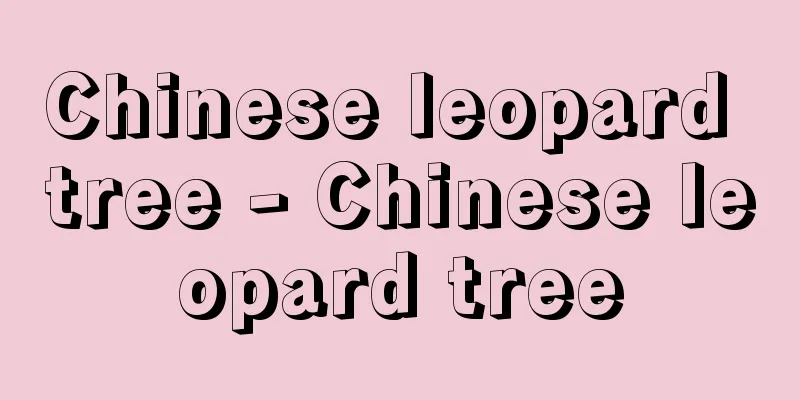Chinese leopard tree - Chinese leopard tree

|
A perennial plant of the Lamiaceae family (APG classification: Lamiaceae). Native to China, it was introduced to Japan around the 17th century. It is cultivated for its edible underground stems, but the amount cultivated is small. It is also cultivated to a certain extent in Europe and the United States. The stems are 60 cm tall, and the leaves are alternate, long oval, and wrinkled. In early autumn, the top of the stem bears dense spikes of pale purple lip-shaped flowers. As autumn progresses and the above-ground parts wither, the tips of the underground stems swell to about 3 cm long and 1.5 cm wide, with both ends pointed and the center narrowed into several sections, forming a white caterpillar-like shape. It is harvested in early winter. When boiled, it tastes similar to lily root, and can be boiled or pickled. In New Year's cuisine, it is dyed red by soaking it in plum vinegar and served with boiled black beans. In European cuisine, it is boiled and fried in butter. [Hoshikawa Kiyochika September 17, 2021] Cultural historyIt is a vegetable native to China, and is thought to have been introduced to Japan in the early Edo period, as it appears in the Tashikihen (1612). The Saifu (1704) states that it can be added to salads and soups, dipped in miso, and it seems that it was also eaten as a sweet dipped in syrup. Chinese artichoke is used in New Year's osechi cuisine as an auspicious plant, along with chiyoroiki, chorokiki, and choroiimo. It is also spelled as asadew leek, but the origin of the word is said to be based on chirongi, which means earthworm in Korean. The rhizome of Chinese artichoke is long and has many nodes, which is somewhat reminiscent of an earthworm. Its Chinese name, sosekisan, is a name that resembles a silkworm. Its other name, kanroshi, comes from its taste. [Hiroshi Yuasa September 17, 2021] ©Shogakukan "> Chinese artichoke pickled in plum vinegar Source: Shogakukan Encyclopedia Nipponica About Encyclopedia Nipponica Information | Legend |
|
シソ科(APG分類:シソ科)の多年草。中国原産で、日本へは17世紀ころに渡来した。地下茎を食用とするため栽培されるが、栽培量は少ない。欧米でも多少栽培される。茎は高さ60センチメートル、葉は互生し、長卵形でしわがある。初秋、茎頂に淡紫色の唇形花を穂状に密につける。秋が深まり、地上部が枯れてくるにつれて地下茎の先が肥大し、長さ3センチメートル、太さ1.5センチメートルほどで、両端はとがり、中央部が数段にくびれた白いイモムシ状となる。初冬に収穫する。煮るとユリ根に似た味がし、煮食したり、漬物にする。正月料理では、梅酢に浸(つ)けて赤く染めたものを、黒豆を煮たものに添える。欧風料理ではゆでてバター炒(いた)めなどにする。 [星川清親 2021年9月17日] 文化史中国原産の野菜で、日本には江戸時代初期に伝わったとみられ、『多識(たしき)編』(1612)に載る。『菜譜(さいふ)』(1704)には、和(あ)え物、吸い物に入れ、みそにつけてよしとあり、蜜(みつ)につけ菓子としても食べていたようである。チョロギは千代老木、長老貴、長老芋をあて、縁起植物として正月のおせち料理に使う。さらに、朝露葱とも綴(つづ)られるが、語源は朝鮮語でミミズを意味するチーロンイに基づくという。チョロギの根茎は節が多くて長く、ちょっとミミズを思わせる。中国名の草石蚕(そうせきさん)もそれをカイコに見立てた名。別名の甘露子(かんろし)は味による。 [湯浅浩史 2021年9月17日] ©Shogakukan"> チョロギの梅酢漬け 出典 小学館 日本大百科全書(ニッポニカ)日本大百科全書(ニッポニカ)について 情報 | 凡例 |
Recommend
Stamp Act
A taxation law for the North American colonies en...
Anniversary of death
The day of death of the deceased. It is called th...
Stylocheiron carinatum (English spelling) Stylocheironcarinatum
…Antarctic krill are abundant not only in the Ant...
Caesaropapism (English spelling) German
It means that the authority of the emperor is sup...
Ephyra subclass - Ephyra acqua
...life cycle is complex, with some species repro...
Altheim, F. - There is
…Alongside Weber and Rostovtsev, the Soviet Union...
Issue; drawing
The act of issuing bills and checks. It is a type ...
Elegant writing - Gabun
〘 noun 〙 Elegant writing. Especially the kana writ...
Muramatsu [town] - Muramatsu
A former town in Nakakanbara County, central Niiga...
Evans, Sir Martin J.
Born January 1, 1941. Stroud. British scientist. H...
Nogurumi - Nogurumi
A deciduous tree of the walnut family that grows i...
Ikeda Shounyu
...A military commander in the Azuchi-Momoyama pe...
EEC - Electrical Engineering
European Economic Community. An organization for r...
800 Women's Country - Happyakusokufukoku
A Tu lord state located outside the border of Yunn...
Phillipsite (English spelling)
A type of mineral. Its chemical composition is KCa...

![Ryugasaki [city] - Ryugasaki](/upload/images/67cd295cec7a7.webp)







